Accepted Scientific Name: Halophytum ameghinoi Speg.
Anales Mus. Nac. Hist. Nat. Buenos Aires 7: 153. 1902

Tetragonia ameghinoi (Halophytum ameghinoi) Photo by: Carolina González
Fruiting habit, Neuquén province, Argentina.
Origin and Habitat: Antarctic and temperate Patagonia, Argentina (Catamarca, Chubut, La Rioja, Mendoza, Neuquen, Río Negro, Santa Cruz, San Juan, San Luis).
Altitude range: 0-2500 metres above sea level.
Habitat and ecology: Halophytum ameghinoiSN|30931]]SN|30931]] is endemic to the arid and semi-arid lands of the Argentine Monte ecoregion, where it is found in open scrubland and very often growing on bare soil in areas that receive little rainfall (80-250 mm).
Synonyms:
Common Names include:
CHINESE (中文): 浜藜叶科
KOREAN (한국어): 할로피툼 아메그히노이
RUSSIAN (Русский): Галофитум
Description: Halophytum ameghinoiSN|30931]]SN|30931]], the sole species of family Halophythaceae, is a remarkable taxon belonging to Order Caryophyllales. It is a succulent annual herbaceous plant with simple, fleshy, alternate leaves. Often highly branched (fresh, weigh more than 10 kg) and 20-30 cm tall. The plants are monoecious, with solitary female flowers and inflorescences of male flowers on the same plant.
Stems: Extended and decumbent, glabrous. Branches up to 50-60 cm.
Roots: Fibrous.
Leaves: Succulent, alternate, simple, exstipulate, usually green or purple, of (8) 12-25 (31) mm long, 2.5-5 mm in diameter, straight or somewhat curved.
Inflorescence of male flowers: Densely strobilate, terminal spikes, 7 to 12 mm long. Staminate flowers1 whorled, with 4 tepals ± 4 mm, barely petal-like, 3-nerved, valvate-decussate. Stamens alternate with perianth segments. Anthers white dehiscing by pores. Pollen cuboid, hexaporate. Calyx 4 sepaled; 1 whorled.
Female flowers: Solitary in the 4–5 uppermost leaf axils. Calyx and perianth absent, ovary ± 0.45 mm tall, ovule single Halophytum ameghinoiSN'>30931]SN|30931]] was found to be 2n = 24.
Notes: Halophytum ameghinoiSN|30931]]SN|30931]] was initially described as a member of the genus Tetragonia, in the Aizoaceae and then included in Chenopodiaceae. However, differences in ovary, pollen, and fruit morphology showed that this relationship is unlikely. Later, H. ameghinoi was classified in its own family, Halophytaceae, by Soriano who pointed out that it should be considered an independent family with uncertain, inconclusive systematic relationships with families included in Centrospermae. The Halophytaceae have relationship with Chenopodiaceae (similaar pollen structure), Basellaceae (similar pollen and floral, morphology, and vegetative characters), Portulacaceae (similar stomata, floral morphology, and chromosome number). Among the families of Order Caryophyllales, the evolutionary relationships of Halophytum with other groups have remained elusive and this plant may be related to Cactaceae, Amaranthaceae, Basellaceae, Didiereaceae, and Portulacaceae. In a phylogenetic context, anemophily of Halophytum is of isolated occurrence within Caryophyllales, and uniovulate ovaries in sister clades probably represent a prerequisite for evolution of anemophily.
Bibliography: Major references and further lectures:
1) Stevens, P. F. (2001 onwards). Angiosperm Phylogeny Website. Version 12, July 2012 [and more or less continuously updated since]. http://www.mobot.org/MOBOT/research/APweb/
2) Samuel F. Brockington, Roolse Alexandre, Jeremy Ramdial, Michael J. Moore, Sunny Crawley, Amit Dhingra, Khidir Hilu, Douglas E. Soltis & Pamela S. Soltis "Phylogeny of the Caryophyllales Sensu Lato: Revisiting Hypotheses on Pollination Biology and Perianth Differentiation in the Core Caryophyllales", in International Journal of Plant Sciences, 170(5), 2009, S. 627-643. on line: <http://www.efn.uncor.edu/departamentos/divbioeco/otras/bioflor/pdf/Pozner%20&%20Cocucci%202006.pdf>
3) L. Watson and M. J. Dallwitz “The families of flowering plants” DELTA home on line: <http://delta-intkey.com/angio/www/halophyt.htm>
4) Juan Héctor Hunziker, Raúl Pozner, Alejandro Escobar “Chromosome number in Halophytum ameghinoi (Halophytaceae)” Plant Systematics and Evolution 2000, Volume 221, Issue 1-2, pp 125-127
5) Ana M. Anton, Tania Hernández-Hernández, Arturo De-Nova, Victoria Sosa “Evaluating the phylogenetic position of the monotypic family Halophytaceae (Portulacinae, Caryophyllales) based on plastid and nuclear molecular data sets” Botanical Sciences 92 (3): 351-361, 2014
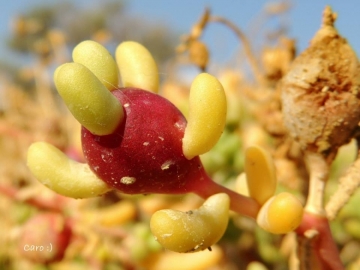 A sincarpus (several fruits combining to form a multiple multiple fruit embedded in the swollen stem apex) (Halophytum ameghinoi) Photo by: Carolina González
A sincarpus (several fruits combining to form a multiple multiple fruit embedded in the swollen stem apex) (Halophytum ameghinoi) Photo by: Carolina González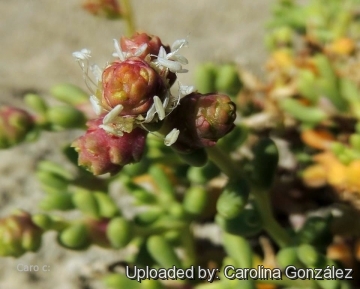 White anthers decorate decorate the dense terminal male inflorescences. (Halophytum ameghinoi) Photo by: Carolina González
White anthers decorate decorate the dense terminal male inflorescences. (Halophytum ameghinoi) Photo by: Carolina González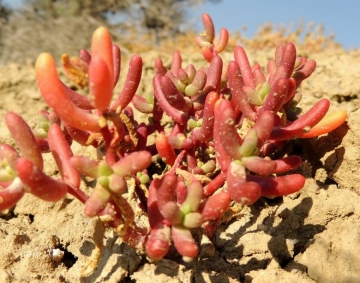 Blooming habit, Neuquén province, Argentina. (Halophytum ameghinoi) Photo by: Carolina González
Blooming habit, Neuquén province, Argentina. (Halophytum ameghinoi) Photo by: Carolina González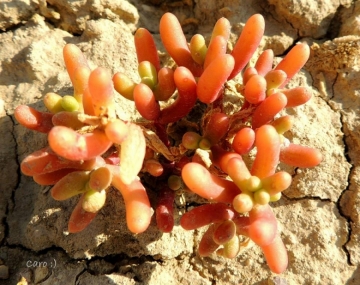 Blooming habit, Neuquén province, Argentina. (Halophytum ameghinoi) Photo by: Carolina González
Blooming habit, Neuquén province, Argentina. (Halophytum ameghinoi) Photo by: Carolina González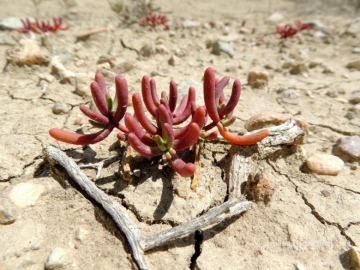 Habit, Neuquén province, Argentina. (Halophytum ameghinoi) Photo by: Carolina González
Habit, Neuquén province, Argentina. (Halophytum ameghinoi) Photo by: Carolina González Male inflorescences. (Halophytum ameghinoi) Photo by: Carolina González
Male inflorescences. (Halophytum ameghinoi) Photo by: Carolina González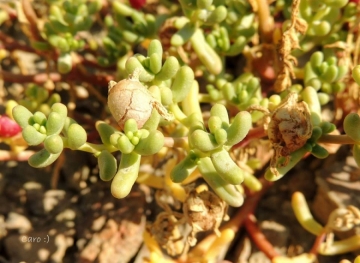 Mature (splitting) fruits. Neuquén province, Argentina. (Halophytum ameghinoi) Photo by: Carolina González
Mature (splitting) fruits. Neuquén province, Argentina. (Halophytum ameghinoi) Photo by: Carolina González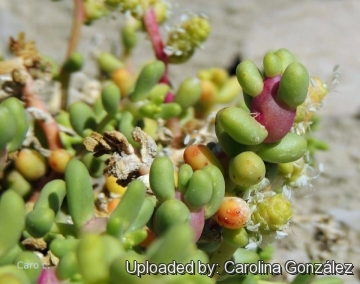 Male and female inflorescences. (Halophytum ameghinoi) Photo by: Carolina González
Male and female inflorescences. (Halophytum ameghinoi) Photo by: Carolina GonzálezCultivation and Propagation: This plant is seldom cultivated.



















